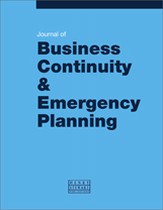Considering employee needs during a catastrophe requires innovative recovery plans: Why traditional workplace recovery solutions are outdated
Abstract
Mobile technology has changed the way we live and operate, with co-working, flexible spaces and home office solutions that offer us the freedom to work when and where we choose. However, when disaster strikes the workplace, people are often the last to be considered in the recovery process. This paper examines strategies for businesses and their employees to continue working after a disaster strikes. It explores the trends in the market, the benefits and drawbacks of different approaches and the attitudes of continuity experts and small business owners who have the responsibility to ensure that businesses, and people, continue to function, even when their main place of work is inaccessible. Informed by expertise and experience, this paper also draws on the extant literature, as well as bespoke research targeted at both continuity professionals and business decision-makers, to discover more about attitudes to disaster recovery.
The full article is available to subscribers to the journal.
Author's Biography
Joe Sullivan is Managing Director for Workplace Recovery at Regus and has led in the development, management and planning of recovery for thousands of organisations. In 2016, under his leadership, Regus was awarded the BCI Continuity and Resilience Innovative Product of the Year award in Europe and Asia for the development of a new, dynamic recovery solution that is transforming the way businesses recover during a disaster. His previous roles include head of infrastructure product management with Sungard AS and management positions at Level 3 Communications and Ernst & Young.
Citation
Sullivan, Joe (2017, March 1). Considering employee needs during a catastrophe requires innovative recovery plans: Why traditional workplace recovery solutions are outdated. In the Journal of Business Continuity & Emergency Planning, Volume 10, Issue 3. https://doi.org/10.69554/VAJV9518.Publications LLP
